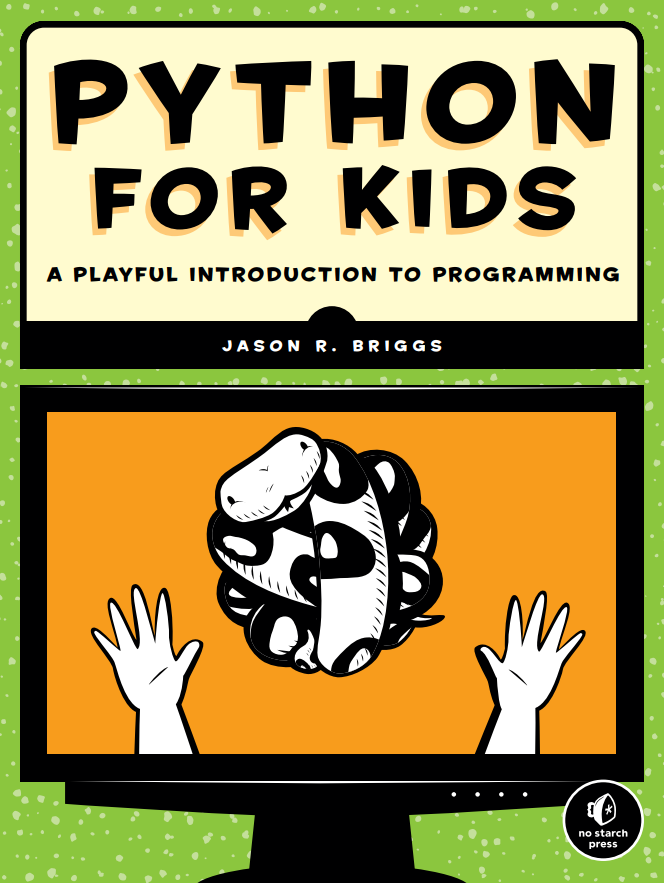Introduction
Books that teach python from scratch are dime a dozen - what then, makes certain books stand apart from others? If "empathising with your audience" is too highfalutin', then perhaps "tailoring the content to the audience" is perhaps what clinches the deal. Who then, is the audience for this book - and what does it offer? Read on to find out.
This book is for the beginner to programming. In fact, although the book is titled "Python for Kids", anyone interested in computer programming would find it interesting, whether that’s a child or an adult.
In fact, the humour, though seemingly for kids, may need an adult to decipher. I’d say the perfect audience for this book would be a child guided by an adult.
Book Highlights
The book is divided into three parts. The first part covers all the basics of programming, like variables, loops and conditionals. This is the major part of the book, covering half of the 300 pages. The next two parts use that knowledge to build some games.
Let’s look at the three parts in brief.
Part 1: Basics + turtle
This part teaches the basics of programming. Simultaneously, the reader is introduced to the turtle module. The book then illustrates many concepts going back and forth between python code, and illustrating the same using turtle concepts.
anugachtu pravah - a Sanskrit term became popular when two celebrities had it tattoo-ed on their arms. It means - ‘Go with the flow’. This part does it really well - for instance, teaching simple turtle movements before conditionals and loops. Covers all basics, including modules, data structures and even classes/objects (though this topic is considerably more complex, the author uses a befitting example)
The chapters on builtin functions and modules both felt a bit bloated for this audience level. However, the turtle chapter has lots of cool examples and explanations, and every chapter ends with a few programming puzzles.
Part 1 ends with a chapter on tkinter and how to create a windowed application. There is enough useful material even if one is not planning to use tkinter later.
Part 2: Bounce
This part uses tkinter to create an Arkanoid clone game. Guides the learner nicely through making a simple game. Has exercises for adding features like recording score.
Part 3: Mr. Stickman Races for the Exit
The final part of the book takes the reader through all the steps in creating a more complex game. These include:
- Planning out a game
- Sprite creation in GIMP.
- Movement and collision detection.
- Basic testing.
- Further feature ideas to implement.
- An introduction to other languages (JS, Ruby etc) and modules (PyGame).
Over the course of four chapters, a small game engine is developed using tkinter. The reader learns how to animate the sprite, handle key inputs, detect collisions and so on. This chapter puts all the concepts to use to make something interesting. The complexity of the concepts is quite a bit higher in this section and there is a lot of code to type out.
Summary
A superb book for those wanting to learn Python with a companion book. The colorful illustrations and language is apt for the target audience. Although the book was originally released in 2013, it still holds up a decade later. A second edition was released last year, updating all the code to the latest Python 3 style. Heartily recommended!
PRO
- Great illustrations, typeface and language: Just what you need for a beginner audience. The book is worth the price for the illustrations alone!
- Humour: The book is full of funny examples - keep an eye out for them!
- Anticipates issues kids might face when learning to do the tasks in the book - and offers solutions.
- In a similar vein, Notes and Warnings throughout the text are very useful and apt.
CON
- The companion website doesn’t seem to exist now, it just redirects to the product page on No Starch Press 🙁
- A couple of chapters in part 1 feel bloated, especially considering the audience level.
Did you like this article?
If you liked this article, consider subscribing to this site. Subscribing is free.
Why subscribe? Here are three reasons:
- You will get every new article as an email in your inbox, so you never miss an article
- You will be able to comment on all the posts, ask questions, etc
- Once in a while, I will be posting conference talk slides, longer form articles (such as this one), and other content as subscriber-only

